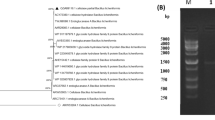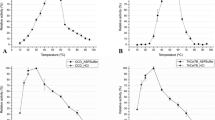Abstract
Rhizobial symbiosis provides the nitrogen for the leguminous plant through fixation of the gaseous nitrogen component of air. For the bacteria in the plant root-hair wall, carboxymethylcellulase (CM-cellulase, EC 3.2.1.4) may be the key enzyme in this symbiotic process, with polygalacturonase (pectinase, EC 3.2.1.15) another critical enzyme involved early in the mechanism of nitrogen supply. The precise cytosolic location, function and expression of CM-cellulase are still uncertain, however. To detect the relevant enzyme activity in Sinorhizobium fredii CCRC15769, various assay methods were used including double-layer plate assay and quantitation of reducing sugar products. After sonication of the cell pellet, ammonium sulphate precipitation, gel filtration, and ion-exchange chromatography are the preferred methods for derivation of the purified protein, with CM-cellulase characterized as follows: purification ratio, 33.35; recovery, 10.8%; and specific activity, 0.053 U mg−1. The endoglucanase in the purified samples was resolved using native and sodium dodecyl sulphate-polyacrylamide-gel electrophoresis; it was then assayed with an ultrathin CM-cellulose overlay stained with Congo Red. Two CM-cellulase isozymes were determined by native activity stain assay, with gel-filtration revealing molecular weights of approximately 196 and 30 kD; the SDS-PAGE activity gel resolved four enzyme subunits of 94, 67, 37, and 30 kD. It is suggested that the CM-cellulase in S.fredii CCRC15769 is a two-isozyme form, one a trimer of 196 kD (94, 67 and 37 kD), and the other a 30 kD monomer.
Similar content being viewed by others
References
Ausmee, N., Jonsson, H., Hoglund, S., Ljunggren, H. & Lindberg, M. 1999 Structural and putative regulatory genes involved in cellulose synthesis in Rhizobium leguminosarum bv. trifolii. Microbiology 145, 1253-1262.
Berthelot, K. & Delmotte, F.M. 1999 Purification and characterization of an ?-glucosidase from Rhizobium sp. (Robinia pseudoacacia L.) strain USDA 4280. Applied and Environmental Microbiology 65, 2907-2911.
Bhat, M.K. & Bhat, S. 1997 Cellulase degrading enzymes and their potential industrial applications. Biotechnology Advances 15, 583-620.
Callaham, D. & Torrey, J. 1981 The structural basis for cellulase production by Rhizobium. Canadian Journal of Botany 59, 1647-1664.
Cruickshank, R.H. & Wade, G.C. 1980 Detection of pectic enzymes in pectin-acrylamide gels. Analytical Biochemistry 107, 177-181.
Dazzo, F. & Hubbell, D. 1982 Control of root hair infection. In Nitrogen Fixation, vol. 2, Rhizobium, ed. Broughton, W. pp. 274-310. Oxford: Clarendon Press. ISBN 0-19854552-5.
Drawert, F. & Krefft, B. 1978 Charakterisierung extrazellularer Proteine und Enzyme aus Pektinkulturfiltraten von Botrytis cinerea. Phytochemistry 17, 887-890.
Hubbell, D. 1981 Legume infection by Rhizobium: a conceptual approach. Bioscience 31, 832-837.
Hubbell, D., Morales, V. & Umail-Garcia, M. 1978 Pectolytic enzymes in Rhizobium. Applied and Environmental Microbiology 35, 210-224.
Iannetta, P.P.M., Mcmillan, G.P. & Sprent, J.I. 1997 Plant cell walldegrading enzymes of Rhizobium Leguminosarum bv. Viciae: their role in avoiding the host-plant defence response. Soil Biology and Biochemistry 29, 1019-1021.
Jimenez-zurdo, J.I., Mateos, P.F., Dazzo, F.B. & Martinez-Molina, E. 1996a Cell-bound cellulase and polygalacturonase production by Rhizobium and Bradyrhizobium species. Soil Biology and Biochemistry 28, 917-921.
Jimenez-zurdo, J.I., Mateos, P.F., Dazzo, F.B. & Martinez-Molina, E. 1996b Influence of the symbiotic plasmid (pSm) on cellulase production by Rhizobium Leguminosarum bv. Trifolii ANU483. Soil Biology and Biochemistry 28, 131-133.
Karpunina, L.V., Soboleva, E.F. & Pronina, O.A. 2000 Effect of agglutinins from Rhizobium leguminosarum strain 252 on the activity of hydrolytic enzymes. Current Microbiology 41, 73-75.
Laemmli, U.K. 1970 Cleavage of structural proteins during the assembly of the head of bacteriophage T4. Nature (London) 227, 680-685.
Ljunggren, H. & Fahraeus, G. 1961 The role of polygalacturonase in root-hair invasion by nodule bacteria. Journal of General Microbiology 26, 521-528.
Lopez, M. & Signer, E. 1987 Degradative enzymes in Rhizobium meliloti. In Molecular Genetics of Plant-microbe Interactions eds. Verma, D. & Brisson, N. pp. 185-187. Dordrecht, The Netherlands: Martinus Nijhoff Publishers. ISBN 90-2473426-6.
Martinez-Molina, E., Morales, V. & Hubbell, D. 1979 Hydrolytic enzyme production of Rhizobium. Applied and Environmental Microbiology 38, 1186-1188.
Martinez-Molina, E. & Olivares, J. 1982 A note on evidence for involvement of pectolytic enzymes in the infection process of Medicago sativa by Rhizobium meliloti. Journal of Applied Bacteriology 52, 453-455.
Mateos, P.F., Jimenez-Zurdo, J.I., Chen, J., Squartini, A., Haack, S.K., Martinez-Molina, E., Hubbell, D.H. & Dazzo, F.B. 1992 Cell-associated pectinolytic and cellulolytic enzymes in Rhizobium leguminosarum biovar, trifolii. Applied and Environmental Microbiology 58, 1816-1822.
McCoy, E. 1932 Infection by Bact. Radicicola in relation to the microchemistry of the host's cell walls. Proceedings of the Royal Society of London Series B, Biological Sciences 110, 514-533.
Morales, V., Martinez-Molina, E. & Hubbell, D. 1984 Cellulase production by Rhizobium. Plant and Soil 80, 407-415.
Nutman, P.S. 1956 The influence of the legume in root nodule symbiosis. A comparative study of host determinants and functions. Biological Reviews (Cambridge) 31, 109-151.
Plazinski, J. & Rolfe, B. 1985 Analysis of the pectolytic activity of Rhizobium and Azospirillum strains isolated from Trifolium repens. Journal of Plant Physiology 120, 181-187.
Ried, J. & Collmer, A. 1985 Activity stain for rapid characterization of pectic enzymes in isoelectric focusing and sodium dodecyl sulphate-polyacrylamide gels. Applied and Environmental Microbiology 50, 615-622.
Saleh-Rastin, N., Petersen, M., Coleman, S. & Hubbell, D. 1991 Rapid plate assay for hydrolytic enzymes of Rhizobium. In The Rhizosphere and Plant Growth, eds. Keister, D. & Cregon, P.B. p. 188. Dordrecht, The Netherlands: Kluwer Academic Publishers. ISBN 0-79231032-2.
Waffenschmidt, S. & Jaenicke, L. 1987 Assay of reducing sugars in the nanomole range with 2,2'-bicinchoninate. Analytical Biochemistry 165, 337-340.
Wood, M. & Stanway, A.P. 2001 Myo-inositol catabolism by Rhizobium in soil: HPLC and enzymatic studies. Soil Biology and Biochemistry 33, 375-379.
Author information
Authors and Affiliations
Rights and permissions
About this article
Cite this article
Hu, CY., Lin, LP. Characterization and purification of hydrolytic enzymes in Sinorhizobium fredii CCRC15769. World Journal of Microbiology and Biotechnology 19, 515–522 (2003). https://doi.org/10.1023/A:1025122714976
Issue Date:
DOI: https://doi.org/10.1023/A:1025122714976




